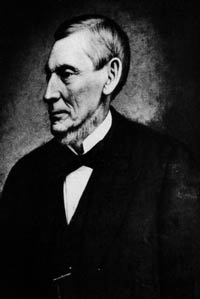Derby History Quiz - Edward
Shelton
Current
Quiz Archives of all quizzes

Quiz #13

Edward N. Shelton
In 2008, he was inducted into the
Derby Hall of Fame.
The answer to this quiz was actually contained in the previous quiz
about Graystone! Yes, that is Edward Nelson Shelton pictured above, and he was the owner
of Graystone. He was the president of the Ousatonic Water Company, but is better known
because the present day city of Shelton is named after him. When the Ousatonic Dam was
opened and cheap water power created a thriving manufacturing industry on the other side
of the Housatonic River, that area of town came to be known as Shelton! Unfortunately, the
opening of the dam also marked the end shad fishing industry farther north.
Our list of winners included:
Derby Neck Library
Markanthony Izzo
Tom Chebro.
The following biography of Edward Nelson is reprinted from "The Story
of Shelton, 1980 Edition" which was comiled by The League of Women Voters of Shelton,
Inc.
Edward Nelson Shelton, for whom the city of Shelton was
named, is so seldom mentioned in Shelton historical records that many townspeople are
unaware of his importance It is frequently assumed—even by members of the Shelton
family—that the city was named for his nephew, Dr Gould A Shelton, the town *s first health
officer, or Daniel Shelton, the original family settler.
The city 's namesake was born in Huntington on September 4,1812, the youngest
son of Joseph and Charity Lewis Shelton. He attended local schools, the academy in Derby,
spent one year at Partridge*s Scientific and Military Academy, Middletown, Connecticut, and one
winter attending scientific lectures at Yale.
Orcutt *s history mentions briefly that Shelton served in the legislature in
Hartford, representing the Fifth Senatorial District, but gives no date
When Shelton was 24 years old, he moved to Derby, to a section known as
"Birmingham" He was 30 years old when, on July 14,1840, he married Mary Jane
DeForest, member of an old and prominent Derby family Shortly afterward, he built his
famous home, "Greystone," at 9 Seymour Avenue, Derb. It was constructed by the
Hubbell brothers of White Hills, Shelton. Tradition has it that the stone for the mansion
was hauled from Monroe by oxen.
The Sheltons had six children Jane DeForest
(author of The Salt Box House), Louise Josephine, Adelaide (Ada) Stewart, Eugenia
Elizabeth (Mrs Thomas Cornell), Marianna Clarke (Mrs Victor F Allien), and Edward DeForest
Shelton
"Greystone" remained in the family until 1941 Edward 's daughter
"Miss Ada" as she was known, lived there until her death, with her nieces, Mrs
Gertrude Allien Wallis, Miss Marion Aihen, and Miss Beatrice DeForest Allien
The house then stood empty for several years before it was purchased in
1941 by Mrs Frances Osborne Kellogg, in a vain effort to prevent its demolition. After
World War II, it was sold to the City of Derby and razed to provide the site for New
Irving School
Edward Shelton 's fame and fortune lay in the field of industrial development. He
was a most astute business man. In 1836, with N. C. Sanford his brother-in-law, he formed
The Shelton Tack Company. (Sanford came from Woodbury and his son, Henry S. Sanford,
served as ambassador to Belgium).
The Shelton Tack Company, although started in Derby, moved to Shelton
in 1871. Edward Shelton soon became sole owner The firm amassed great wealth. During the
California gold rush, tacks were literally worth their weight in gold, a pound of gold
valued at $192 being even exchange for a pound of tacks.
The tack company was only one of his
interests. He served as president of the Birmingham National Bank from 1848 until his
death in 1894. He helped organize the Derby Savings Bank and served as a vice president.
He was a director of the Birmingham Water Company.
As far as the City of Shelton is concerned,
Edward Shelton is remembered best as organizer and first president of the Ousatonic Water
Power Company, formed in December, 1866, with capital of $322,500 to build a dam
across the Housatonic River.
Primarily through Edward Shelton *s efforts, the
dam was completed October 10, 1870. What followed was an era of local building and
industrialization, not rivaled until the 1960s. This, too, was due largely to Shelton's efforts He
promoted industry along the section served by the new dam, using every means at his
disposal. He furnished capital to companies that would build there, offered favorable
water power franchises, and even built factories.
Little is known of the personal side of
Edward N. Shelton. D. Hamilton Hurd published his "History of Fairfield County"
while Shelton was still alive. He describes the local industrialist as "a man of wise
prudence and generosity, of keen business foresight and great public spirit, having been
always a leader in whatever was for the welfare of the town or the church of which he is a
member, a man of honor and strict integrity, a wise counselor and a true friend."
Orcutt states that Shelton considered the Civil War a national calamity
but still felt it his duty to support the Union wholeheartedly. Like Hurd, he wrote
in Shelton 's lifetime, but his evaluation is less flowery A characteristic of his life has
been that where there was responsibility, he trusted not to others but gave his personal
attention to the matter that there might be no failure
Shelton died in Derby in September, 1894, at the age of 82
He is buried with his family in Oak Cliff Cemetery, Derby, the burial ground which
overlooks the Derby-Shelton Dam, an enterprise he spent most of his life promoting.
To see our earlier quizzes and learn more about Derby's unique
history, click here.

 Back
to Derby Home page Back
to Derby Home page
|
